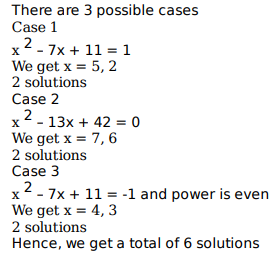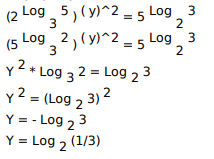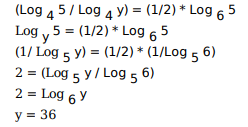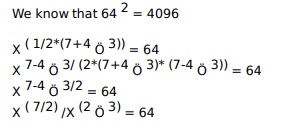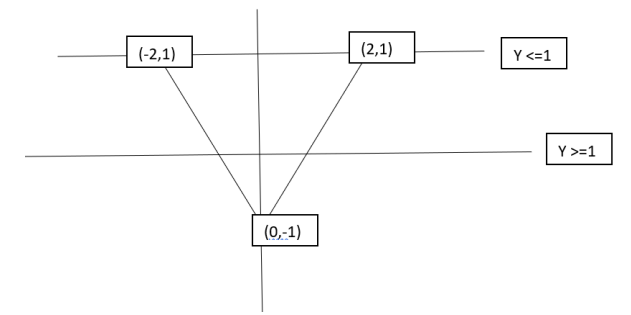Live Updates
• CATKing has launched new chat bot.

• New video on Logs has been released.
495
Learners
asked the doubt

Previous Year Questions
The passage below is accompanied by a set of questions. Choose the best answer to each question.
The word ‘anarchy’ comes from the Greek anarkhia, meaning contrary to authority or without a ruler, and was used in a derogatory sense until 1840, when it was adopted by Pierre-Joseph Proudhon to describe his political and social ideology. Proudhon argued that organization without government was both possible and desirable. In the evolution of political ideas, anarchism can be seen as an ultimate projection of both liberalism and socialism, and the differing strands of anarchist thought can be related to their emphasis on one or the other of these.
Historically, anarchism arose not only as an explanation of the gulf between the rich and the poor in any community, and of the reason why the poor have been obliged to fight for their share of a common inheritance, but as a radical answer to the question ‘What went wrong?’ that followed the ultimate outcome of the French Revolution. It had ended not only with a reign of terror and the emergence of a newly rich ruling caste, but with a new adored emperor, Napoleon Bonaparte, strutting through his conquered territories.
The anarchists and their precursors were unique on the political Left in affirming that workers and peasants, grasping the chance that arose to bring an end to centuries of exploitation and tyranny, were inevitably betrayed by the new class of politicians, whose first priority was to re-establish a centralized state power. After every revolutionary uprising, usually won at a heavy cost for ordinary populations, the new rulers had no hesitation in applying violence and terror, a secret police, and a professional army to maintain their control.
For anarchists the state itself is the enemy, and they have applied the same interpretation to the outcome of every revolution of the 19th and 20th centuries. This is not merely because every state keeps a watchful and sometimes punitive eye on its dissidents, but because every state protects the privileges of the powerful.
The mainstream of anarchist propaganda for more than a century has been anarchist-communism, which argues that property in land, natural resources, and the means of production should be held in mutual control by local communities, federating for innumerable joint purposes with other communes. It differs from state socialism in opposing the concept of any central authority. Some anarchists prefer to distinguish between anarchist-communism and collectivist anarchism in order to stress the obviously desirable freedom of an individual or family to possess the resources needed for living, while not implying the right to own the resources needed by others. . . .
There are, unsurprisingly, several traditions of individualist anarchism, one of them deriving from the ‘conscious egoism’ of the German writer Max Stirner (1806–56), and another from a remarkable series of 19th-century American figures who argued that in protecting our own autonomy and associating with others for common advantages, we are promoting the good of all. These thinkers differed from free-market liberals in their absolute mistrust of American capitalism, and in their emphasis on mutualism.
Which one of the following best expresses the similarity between American individualist anarchists and free-market liberals as well as the difference between the former and the latter?
Video Explanation

Explanatory Answer
Individualist anarchism, according to the last paragraph, involves “protecting our own
autonomy and associating with others for common advantages”. The last line of the passage states that these thinkers “differed from free-market liberals in their absolute mistrust of American
capitalism, and in their emphasis on mutualism.”In other words, while both individualist anarchists and free-market thinkers agreed on the importance of individual autonomy, individualist anarchists distrusted capitalism and put emphasis on mutualism while free-market thinkers did not.
All other options mention ideas like state intervention in markets, morally upright capitalism and altrusim which are not discussed in the passage.
The author makes all of the following arguments in the passage, EXCEPT:
Video Explanation

Explanatory Answer
The passage makes no mention of the mainstream mistrust of collectivism.
In the last paragraph, the passage states that “there are, unsurprisingly, several traditions of individualist anarchism..”. So, option A is true.
Option C is true, based on paragraphs 3 and 4: “For anarchists the state itself is the enemy....because
every state keeps a watchful and sometimes punitive eye on its dissidents..”. Paragraph 3 talks about the “violence and terror” applied by centralised state power.
Option D is also true, based on paragraphs 2 and 3: French Revolution “had ended not only with a
reign of terror and the emergence of a newly rich ruling caste” and “workers and peasants, grasping the chance that arose to bring an end to centuries of exploitation and tyranny, were inevitably betrayed by the new class of politicians...”.
According to the passage, what is the one idea that is common to all forms of anarchism?
Video Explanation

Explanatory Answer
The passage clearly states that “for anarchists the state itself is the enemy and they have applied the same interpretation to the outcome of every revolution of the 19th and 20th centuries.”.
Note that option B is incorrect because it talks of the ‘primacy’ of the individual while anarchism puts emphasis on mutualism.
The author believes that the new ruling class of politicians betrayed the principles of the French Revolution, but does not specify in what way. In the context of the passage, which statement below is the likeliest explanation of that betrayal?
Video Explanation

Explanatory Answer
The passage discusses the French Revolution and goes on to state in paragraph 3 that “after every revolutionary uprising, usually won at a heavy cost for ordinary populations, the new rulers had no hesitation in applying violence and terror, a secret police, and a professional army to maintain their control.”So, option A is the correct choice.
Of the following sets of concepts, identify the set that is conceptually closest to the concerns of the passage.
Video Explanation

Explanatory Answer
Only options A and D mention anarchism, which is the main idea of the passage. Option A does not mention ‘freedom’ and individual’, which are discussed in the last two paragraphs. So, D is the best choice.
The passage below is accompanied by a set of questions. Choose the best answer to each question.
In the late 1960s, while studying the northern-elephant-seal population along the coasts of Mexico and California, Burney Le Boeuf and his colleagues couldn’t help but notice that the threat calls of males at some sites sounded different from those of males at other sites. . . . That was the first time dialects were documented in a nonhuman mammal. . . .
All the northern elephant seals that exist today are descendants of the small herd that survived on Isla Guadalupe [after the near extinction of the species in the nineteenth century]. As that tiny population grew, northern elephant seals started to recolonize former breeding locations. It was precisely on the more recently colonized islands where Le Boeuf found that the tempos of the male vocal displays showed stronger differences to the ones from Isla Guadalupe, the founder colony.
In order to test the reliability of these dialects over time, Le Boeuf and other researchers visited Año Nuevo Island in California—the island where males showed the slowest pulse rates in their calls—every winter from 1968 to 1972. “What we found is that the pulse rate increased, but it still remained relatively slow compared to the other colonies we had measured in the past” Le Boeuf told me.
At the individual level, the pulse of the calls stayed the same: A male would maintain his vocal signature throughout his lifetime. But the average pulse rate was changing. Immigration could have been responsible for this increase, as in the early 1970s, 43 percent of the males on Año Nuevo had come from southern rookeries that had a faster pulse rate. This led Le Boeuf and his collaborator, Lewis Petrinovich, to deduce that the dialects were, perhaps, a result of isolation over time, after the breeding sites had been recolonized. For instance, the first settlers of Año Nuevo could have had, by chance, calls with low pulse rates. At other sites, where the scientists found faster pulse rates, the opposite would have happened—seals with faster rates would have happened to arrive first.
As the population continued to expand and the islands kept on receiving immigrants from the original population, the calls in all locations would have eventually regressed to the average pulse rate of the founder colony. In the decades that followed, scientists noticed that the geographical variations reported in 1969 were not obvious anymore. . . . In the early 2010s, while studying northern elephant seals on Año Nuevo Island, [researcher Caroline] Casey noticed, too, that what Le Boeuf had heard decades ago was not what she heard now. . . . By performing more sophisticated statistical analyses on both sets of data, [Casey and Le Boeuf] confirmed that dialects existed back then but had vanished. Yet there are other differences between the males from the late 1960s and their great-great-grandsons: Modern males exhibit more individual diversity, and their calls are more complex. While 50 years ago the drumming pattern was quite simple and the dialects denoted just a change in tempo, Casey explained, the calls recorded today have more complex structures, sometimes featuring doublets or triplets. . . .
Which one of the following conditions, if true, could have ensured that male northern elephant seal dialects did not disappear?
Video Explanation

Explanatory Answer
According to the passage, the possible reason for dialects disappearing is that “as the population continued to expand and the islands kept on receiving immigrants from the original population, the calls in all locations would have eventually regressed to the average pulse rate of the founder colony”. If, instead, the call tempo of the immigrant seals changed to match that of the host colony (each of which has a different dialect), then dialects would be different.
Option A is incorrect as it is the immigrant male seals that change the average call tempo. Option B states exactly what happened, resulting in the diappearance of dialects. The scenario in option C would not change the outcome in any way.
All of the following can be inferred from Le Boeuf’s study as described in the passage EXCEPT that:
Video Explanation

Explanatory Answer
According to the passage, over time, with migrations, the calls regressed to the average pulse rate of the founder colony in Isla Guadalupe. The passage does not indicate that the influx of new northern elephant seals into Año Nuevo Island would have made the call pulse rate of its male seals exceed that of those at Isla Guadalupe.
All other options can be inferred:
Option A: “At the individual level, the pulse of the calls stayed the same: A male would maintain his vocal signature throughout his lifetime.”
Option C: “This led Le Boeufvand his collaborator, Lewis Petrinovich, to deduce that the dialects were, perhaps, a result of isolation over time, after the breeding sites had been recolonized.”
Option D: “In the decades that followed, scientists noticed that the geographical variations reported in 1969 were not obvious anymore.”
Which one of the following best sums up the overall history of transformation of male northern elephant seal calls?
Video Explanation

Explanatory Answer
The last few lines of the passage have the answer: “Modern males exhibit more individual diversity, and their calls are more complex. While 50 years ago the drumming pattern was quite simple and the dialects denoted just a change in tempo, Casey explained, the calls recorded today have more complex structures”.
From the passage it can be inferred that the call pulse rate of male northern elephant seals in the southern rookeries was faster because:
Video Explanation

Explanatory Answer
Note the observation in paragraph 4: “At other sites, where the scientists found faster pulse rates, the opposite would have happened—seals with faster rates would have happened to arrive first.”
The passage below is accompanied by a set of questions. Choose the best answer to each question.
Few realise that the government of China, governing an empire of some 60 million people during the Tang dynasty (618–907), implemented a complex financial system that recognised grain, coins and textiles as money. . . . Coins did have certain advantages: they were durable, recognisable and provided a convenient medium of exchange, especially for smaller transactions. However, there were also disadvantages. A continuing shortage of copper meant that government mints could not produce enough coins for the entire empire, to the extent that for most of the dynasty’s history, coins constituted only a tenth of the money supply. One of the main objections to calls for taxes to be paid in coin was that peasant producers who could weave cloth or grow grain – the other two major currencies of the Tang – would not be able to produce coins, and therefore would not be able to pay their taxes. . . .
As coins had advantages and disadvantages, so too did textiles. If in circulation for a long period of time, they could show signs of wear and tear. Stained, faded and torn bolts of textiles had less value than a brand new bolt. Furthermore, a full bolt had a particular value. If consumers cut textiles into smaller pieces to buy or sell something worth less than a full bolt, that, too, greatly lessened the value of the textiles. Unlike coins, textiles could not be used for small transactions; as [an official] noted, textiles could not “be exchanged by the foot and the inch” . . .
But textiles had some advantages over coins. For a start, textile production was widespread and there were fewer problems with the supply of textiles. For large transactions, textiles weighed less than their equivalent in coins since a string of coins . . . could weigh as much as 4 kg. Furthermore, the dimensions of a bolt of silk held remarkably steady from the third to the tenth century: 56 cm wide and 12 m long . . . The values of different textiles were also more stable than the fluctuating values of coins. . . .
The government also required the use of textiles for large transactions. Coins, on the other hand, were better suited for smaller transactions, and possibly, given the costs of transporting coins, for a more local usage. Grain, because it rotted easily, was not used nearly as much as coins and textiles, but taxpayers were required to pay grain to the government as a share of their annual tax obligations, and official salaries were expressed in weights of grain. . . .
In actuality, our own currency system today has some similarities even as it is changing in front of our eyes. . . . We have cash – coins for small transactions like paying for parking at a meter, and banknotes for other items; cheques and debit/credit cards for other, often larger, types of payments. At the same time, we are shifting to electronic banking and making payments online. Some young people never use cash [and] do not know how to write a cheque . . .
In the context of the passage, which one of the following can be inferred with regard to the use of currency during the Tang era?
Video Explanation

Explanatory Answer
The last paragraph has the answer: “In actuality, our own currency system today has some similarities even as it is changing in front of our eyes...”
According to the passage, the modern currency system shares all the following features with that of the Tang, EXCEPT that:
Video Explanation

Explanatory Answer
The last paragraph states that the modern currency system “is changing in front of our eyes” and describes the transformation taking place. According to the passage, both the modern currency system and that of Tang use different materials as currency, different currencies for different situations and the currencies fluctuate in value from time to time.
When discussing textiles as currency in the Tang period, the author uses the words “steady” and “stable” to indicate all of the following EXCEPT:
Video Explanation

Explanatory Answer
Note the context in which the author uses the given words in paragraph 3. The author touches upon the reliable supply, measurements and quality of textiles. Transportation is not mentioned.
During the Tang period, which one of the following would not be an economically sound decision for a small purchase in the local market that is worth one-eighth of a bolt of cloth?
Video Explanation

Explanatory Answer
Note the context in which the author uses the given words in paragraph 3. The author touches upon the reliable supply, measurements and quality of textiles. Transportation is not mentioned.
The passage below is accompanied by a set of questions. Choose the best answer to each question.
Vocabulary used in speech or writing organizes itself in seven parts of speech (eight, if you count interjections such as Oh! and Gosh! and Fuhgeddaboudit!). Communication composed of these parts of speech must be organized by rules of grammar upon which we agree. When these rules break down, confusion and misunderstanding result. Bad grammar produces bad sentences. My favorite example from Strunk and White is this one: “As a mother of five, with another one on the way, my ironing board is always up.”
Nouns and verbs are the two indispensable parts of writing. Without one of each, no group of words can be a sentence, since a sentence is, by definition, a group of words containing a subject (noun) and a predicate (verb); these strings of words begin with a capital letter, end with a period, and combine to make a complete thought which starts in the writer’s head and then leaps to the reader’s.
Must you write complete sentences each time, every time? Perish the thought. If your work consists only of fragments and floating clauses, the Grammar Police aren’t going to come and take you away. Even William Strunk, that Mussolini of rhetoric, recognized the delicious pliability of language. “It is an old observation,” he writes, “that the best writers sometimes disregard the rules of rhetoric.” Yet he goes on to add this thought, which I urge you to consider: “Unless he is certain of doing well, [the writer] will probably do best to follow the rules.”
The telling clause here is Unless he is certain of doing well. If you don’t have a rudimentary grasp of how the parts of speech translate into coherent sentences, how can you be certain that you are doing well? How will you know if you’re doing ill, for that matter? The answer, of course, is that you can’t, you won’t. One who does grasp the rudiments of grammar finds a comforting simplicity at its heart, where there need be only nouns, the words that name, and verbs, the words that act.
Take any noun, put it with any verb, and you have a sentence. It never fails. Rocks explode. Jane transmits. Mountains float. These are all perfect sentences. Many such thoughts make little rational sense, but even the stranger ones (Plums deify!) have a kind of poetic weight that’s nice. The simplicity of noun-verb construction is useful—at the very least it can provide a safety net for your writing. Strunk and White caution against too many simple sentences in a row, but simple sentences provide a path you can follow when you fear getting lost in the tangles of rhetoric—all those restrictive and nonrestrictive clauses, those modifying phrases, those appositives and compound-complex sentences. If you start to freak out at the sight of such unmapped territory (unmapped by you, at least), just remind yourself that rocks explode, Jane transmits, mountains float, and plums deify. Grammar is . . . the pole you grab to get your thoughts up on their feet and walking.
Which one of the following quotes best captures the main concern of the passage?
Video Explanation

Explanatory Answer
According to the passage, grammar is fundamental to language. When grammar rules break down, confusion results. So, the main concern of the passage is best expressed by the line "bad grammar produces bad sentences."
Options A and B are easily eliminated, as they are about specific aspects of grammar. Option C is close, as this is also one of the concerns of the author-- a person may not be able to judge if they are "doing well" in their use of language. But between C and D, D is more general and the better choice.
Which one of the following statements, if false, could be seen as supporting the arguments in the passage?
Video Explanation

Explanatory Answer
Trickily worded question. One statement among the given ones, if false, supports the arguments of the passage. A better way to approach this question would be to find the statement, which, if true, does not support the arguments of the passage.
According to the passage, "Nouns and verbs are the two indispensable parts of writing." Option B, if true, states the exact opposite of what the passage says. So, B is the correct choice.
Note that options A, C and D, if true, support the arguments in the passage.
All of the following statements can be inferred from the passage EXCEPT that:
Video Explanation

Explanatory Answer
Though the passage says that there is "comforting simplicity" at the heart of grammar, it does not imply that the purpose of grammar is to make sentences simple.
Statements A, C and D can be inferred from these references in passage: "...a sentence is, by definition, a group of words containing a subject (noun) and a predicate (verb)...", "Must you write complete sentences each time, every time? Perish the thought", and "If your work consists only of fragments and floating clauses, the Grammar Police aren’t going to come and take you away."
“Take any noun, put it with any verb, and you have a sentence. It never fails. Rocks explode. Jane transmits. Mountains float.” None of the following statements can be seen as similar EXCEPT:
Video Explanation

Explanatory Answer
"None of the statements is similar except..." can be understood as "only one statement is similar to...".
Of the given statements, A and C can be eliminated right away. Consider B. One apple tree in a field does not make an orchard. This is an exaggeration, while the given sentence is not. D, on the other hand, is similar to the given sentence.
Inferring from the passage, the author could be most supportive of which one of the following practices?
Video Explanation

Explanatory Answer
The author urges writers to follow the rules of grammar: "...I urge you to consider: 'Unless he is certain of doing well, [the writer] will probably do best to follow the rules.'”
So, the author is most likely to be supportive of a tool that helps writers with grammar rules.
Note that the author is not against the use of rhetoric or critical of grammar rules. So, options A, B and C are easily eliminated.
The four sentences (labelled A, B, C, D) below, when properly sequenced would yield a coherent paragraph. Decide on the proper sequencing of the order of the sentences and key in the sequence of the four numbers as your answer:
A. Tensions and sometimes conflict remain an issue in and between the 11 states in South East Asia (Brunei Darussalam, Cambodia, Indonesia, Laos, Malaysia, Myanmar, the Philippines, Singapore, Thailand, Timor-Leste and Vietnam).
B. China’s rise as a regional military power and its claims in the South China Sea have become an increasingly pressing security concern for many South East Asian states.
C. Since the 1990s, the security environment of South East Asia has seen both continuity and profound changes.
D. These concerns cause states from outside the region to take an active interest in South East Asian security.
Video Explanation

Explanatory Answer
Of the given sentences, C is the most general and hence the best opening statement. Sentence A, which is about the tensions between states in South East Asia adds to C. B talks about the threat China poses to South East Asian states and follows A. D sums up the paragraph.
The passage given below is followed by four alternate summaries. Choose the option that best captures the essence of the passage.
For nearly a century most psychologists have embraced one view of intelligence. Individuals are born with more or less intelligence potential (I.Q.); this potential is heavily in\xef\xac\x82uenced by heredity and difcult to alter; experts in measurement can determine a person’s intelligence early in life, currently from paper-and-pencil measures, perhaps eventually from examining the brain in action or even scrutinizing his/her genome. Recently, criticism of this conventional wisdom has mounted. Biologists ask if speaking of a single entity called “intelligence” is coherent and question the validity of measures used to estimate heritability of a trait in humans, who, unlike plants or animals, are not conceived and bred under controlled conditions.
Video Explanation

Explanatory Answer
The last line of the paragraph states the main idea: Biologists ask if speaking of a single entity called “intelligence” is coherent and question the validity of measures used to estimate heritability of a trait in humans. Option A rephrases this.
The second half of option B is incorrect. The paragraph says biologists question the validity of measures used to estimate heritability, not the ways in which intelligence is inherited. Options C is not as comprehensive as A. Option D is incorrect as it says intelligence is 'immutable' while the paragraph only says it is difficult to alter.
The four sentences (labelled A, B, C, D) below, when properly sequenced would yield a coherent paragraph. Decide on the proper sequencing of the order of the sentences and key in the sequence of the four numbers as your answer:
A. Relying on narrative structure alone, indigenous significances of nineteenth century San folktales are hard to determine.
B. Using their supernatural potency, benign shamans transcend the levels of the San cosmos in order to deal with social conflict and to protect material resources and enjoy a measure of respect that sets them apart from ordinary people.
C. Selected tales reveal that they deal with a form of spiritual conflict that has social implications and concern conflict between people and living or dead malevolent shamans.
D. Meaning can be elicited, and the tales contextualized, by probing beneath the narrative of verbatim, original-language records and exploring the connotations of highly significant words and phrases.
Video Explanation

Explanatory Answer
Sentence A is the best opening sentence, as it tells us what the 'tales' mentioned in other sentences refer to -- nineteenth century San folktales. Sentence A states that the significance of these tales is "hard to determine". Sentence D tells us how the meaning can be elicited. So, D follows A. Sentence B mentions "shamans"-- who/what these are is clear only from C.Shamans are dead and malevolent. So, C comes before B.
The passage given below is followed by four alternate summaries. Choose the option that best captures the essence of the passage.
For years, movies and television series like Crime Scene Investigation (CSI) paint an unrealistic picture of the “science of voices.” In the 1994 movie Clear and Present Danger an expert listens to a brief recorded utterance and declares that the speaker is “Cuban, aged 35 to 45, educated in the […] eastern United States.” The recording is then fed to a supercomputer that matches the voice to that of a suspect, concluding that the probability of correct identification is 90%. This sequence sums up a good number of misimpressions about forensic phonetics, which have led to errors in real-life justice. Indeed, that movie scene exemplifies the so-called “CSI effect”—the phenomenon in which judges hold unrealistic expectations of the capabilities of forensic science.
Video Explanation

Explanatory Answer
The main idea of the paragraph is conveyed in the last sentence: "Indeed, that movie scene exemplifies the so-called “CSI effect”—the phenomenon in which judges hold unrealistic expectations of the capabilities of forensic science." Option D rephrases this. Also note that all other option are specific to voice recognition. The paragraph is more general and talks of forensic science.
The passage given below is followed by four alternate summaries. Choose the option that best captures the essence of the passage.
As Soviet power declined, the world became to some extent multipolar, and Europe strove to define an independent identity. What a journey Europe has undertaken to reach this point. It had in every century changed its internal structure and invented new ways of thinking about the nature of international order. Now at the culmination of an era, Europe, in order to participate in it, felt obliged to set aside the political mechanisms through which it had conducted its affairs for three and a half centuries. Impelled also by the desire to cushion the emergent unification of Germany, the new European Union established a common currency in 2002 and a formal political structure in 2004. It proclaimed a Europe united, whole, and free, adjusting its differences by peaceful mechanisms.
Video Explanation

Explanatory Answer
The paragraph describes how Europe changed its internal structure and transformed itself into a united whole using peaceful mechanisms in the new multi-polar world. Option D captures all key ideas in the paragraph. The paragraph is specific to the time after Soviet decline and emergent unification of Germany-- a multi-polar world. Options A and C do not include this idea. The paragraph explains how Europe changed its internal structure by adjusting its differences by peaceful mechanisms. Option B does not include this.
The four sentences (labelled A, B, C, D) below, when properly sequenced would yield a coherent paragraph. Decide on the proper sequencing of the order of the sentences and key in the sequence of the four numbers as your answer:
A. Man has used poisons for assassination purposes ever since the dawn of civilization, against individual enemies but also occasionally against armies.
B. These dangers were soon recognized, and resulted in two international declarations—in 1874 in Brussels and in 1899 in The Hague—that prohibited the use of poisoned weapons.
C. The foundation of microbiology by Louis Pasteur and Robert Koch offered new prospects for those interested in biological weapons because it allowed agents to be chosen and designed on a rational basis.
D. Though treaties were all made in good faith, they contained no means of control, and so failed to prevent interested parties from developing and using biological weapons.
Video Explanation

Explanatory Answer
Sentence A is the best opening sentence, as it sets the context. Sentence A talks of poisons used for assassination purposes. C adds to A explaining how the foundation of microbiology helped those interested in biological weapons. BD is a unit: 'these treaties' in D refers to the treaties mentioned in B. ACBD is hence the right order.
Five jumbled up sentences, related to a topic, are given below. Four of them can be put together to form a coherent paragraph. Identify the odd one out and key in the number of the sentence as your answer:
A. For feminists, the question of how we read is inextricably linked with the question of what we read.
B. Elaine Showalter’s critique of the literary curriculum is exemplary of this work.
C. Androcentric literature structures the reading experience differently depending on the gender of the reader.
D. The documentation of this realization was one of the earliest tasks undertaken by feminist critics.
E. More specifically, the feminist inquiry into the activity of reading begins with the realization that the literary canon is androcentric, and that this has a profoundly damaging effect on women readers.
Video Explanation

Explanatory Answer
Tricky question. CE is a possible link, as both talk of androcentric literature. But while C talks about the 'reading experience' depending on the gender of the reader, E talks about the realization that the literary canon is androcentric. These are slightly different ideas.
ED is a strong link, as both talk about the feminists' realization. ED leads on to B, which talks about Elaine Showalter's critique of the literary curriculum. AE is also a strong link, as both sentences relate to the question of what women read.
Between AE and CE, AE is links better to the main idea of the paragraph-- the realization by feminists that what women read has a damaging effect on women readers. AEDB is a cogent paragraph. C is the sentence to be eliminated.
Five jumbled up sentences, related to a topic, are given below. Four of them can be put together to form a coherent paragraph. Identify the odd one out and key in the number of the sentence as your answer:
A. Talk was the most common way for enslaved men and women to subvert the rules of their bondage, to gain more agency than they were supposed to have.
B. Even in conditions of extreme violence and unfreedom, their words remained ubiquitous, ephemeral, irrepressible, and potentially transgressive.
C. Slaves came from societies in which oaths, orations, and invocations carried great potency, both between people and as a connection to the all-powerful spirit world.
D. Freedom of speech and the power to silence may have been preeminent markers of white liberty in Colonies, but at the same time, slavery depended on dialogue: slaves could never be completely muted.
E. Slave-owners obsessed over slave talk, though they could never control it, yet feared its power to bind and inspire—for, as everyone knew, oaths, whispers, and secret conversations bred conspiracy and revolt.
Video Explanation

Explanatory Answer
While all other sentences relate to slave talk, i.e conversations between slaves, C is different, as it is about the significance of oaths, orations and invocations in the societies slaves came from. DABE is a cogent paragraph.
Leaving home at the same time, Amal reaches office at 10:15 am if he travels at 8 km/hr, and at 9:40 am if he travels at 15 km/hr. Leaving home at 9:10 am, at what speed, in km/hr, must he travel so as to reach office exactly at 10 am?
Video Explanation

Explanatory Answer
At 8 km/hr Amal reaches at 10:15 am and at 15km/hr Amal reaches at 9:40 am.
Lets assume the original time takes as T mins and at 15km/hr the time taken would be T-35 mins
Ratio of speeds is inverse of ratio of time.
(8/15) = (T-35/T)
T = 75 mins
Distance = 8 * (75/60) = 10 kms
Time = (50/60) hr
Speed = 10 * (50/60) = 12 km/hr
How many 3-digit numbers are there, for which the product of their digits is more than 2 but less than 7?
Video Explanation

Explanatory Answer
Let’s start with numbers with products 3 4 5 6
113, 131, 311
122, 212, 221
114, 141, 411
115, 151, 511
123, 132, 213, 312, 231, 321
116, 161, 611
21 Solutions
In a group of people, 28% of the members are young while the rest are old. If 65% of the members are literates, and 25% of the literates are young, then the percentage of old people among the illiterates is nearest to
Video Explanation

Explanatory Answer
Let’s Assume there are 400 people
Young – 112
Old – 288
Illiterates = 140
Literates = 260
Young literate = 65
Old Literates = 195
Old illiterates = 93
Old illiterates / Total illiterates = 93/140 = 66%
A solution, of volume 40 litres, has dye and water in the proportion 2 : 3. Water is added to the solution to change this proportion to 2 : 5. If one-fourths of this diluted solution is taken out, how many litres of dye must be added to the remaining solution to bring the proportion back to 2 : 3?
Video Explanation

Explanatory Answer
Solution = 40 litres
Dye = 16 litres
Water = 24 litres
New amount of water in the solution will be 5*8 = 40 litres, i.e 16 litres of water has been added
Solution = 56 litres
We remove ¼ or 14 litres, which leaves 42 litres with dye = 12 litres and water = 30 litres
We need 8 litres of dye to get the proportion to 2:3
An alloy is prepared by mixing three metals A, B and C in the proportion 3:4:7 by volume. Weights of the same volume of the metals A, B and C are in the ratio 5:2:6. In 130 kg of the alloy, the weight, in kg, of the metal C is:
Video Explanation

Explanatory Answer
We have been given the ratio of the volume and weights of the volume (1-unit cube of A will
have a weight of 5x).
Hence to find the actual weights we must multiply the volume and weights of volume.
A : B : C = (3*5 : 4*2 : 7*6) = 15 : 8 : 42
Total weight = 15x + 8x + 42x = 65x = 130
x = 2
Therefore weight of C = 42*2 = 84 Kgs
The mean of all 4 digit even natural numbers of the form 'aabb', where a>0, is
Video Explanation

Explanatory Answer
The even numbers will be of the form
1100, 1122, 1144, 1166, 1188
2200, 2222, 2244, 2266, 2288 and so on
There will be 45 such numbers from 1100 to 9988, the mean will be the 23 number which is 5544
A gentleman decided to treat a few children in the following manner. He gives half of his total stock of toffees and one extra to the first child, and then the half of the remaining stock along with one extra to the second and continues giving away in this fashion. His total stock exhausts after he takes care of 5 children. How many toffees were there in his stock initially?
Video Explanation

Explanatory Answer
These questions work with a backward approach.
The 5 child gets half of what was remaining after 4 child + 1, this essentially means the 5 child
got 2 toffees.
Now the gentleman had 2 toffees after giving half of what was remaining after child 3 + 1, this
means he had 2*(2+1) = 6 left after giving the third child. Hence the 4-child got
0.5*6 + 1 = 4 and 2 were left for 5-child.
Similarly, after giving second child he had 2*(6+1) = 14 toffees
After giving first child he had 2*(14+1) = 30 toffees
Initially he had 2*(30+1) = 62 toffees
A circle is inscribed in a rhombus with diagonals 12 cm and 16 cm. The ratio of the area of circle to the area of rhombus is:
Video Explanation

Explanatory Answer
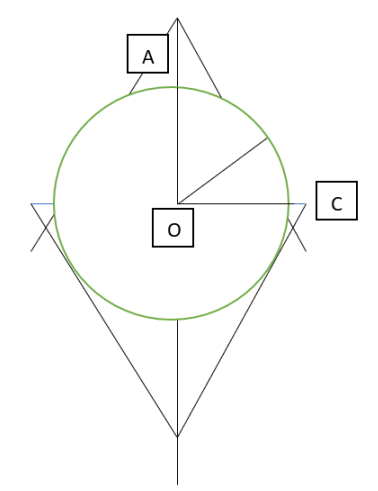
AOC is a right-angle triangle and AC = 10
Perpendicular of a right-angle triangle = P*B/H = 8*6 / 10 = 4.8
Area of circle = P *4.8*4.8 / (0.5*12*16) = 6* P / 25
On a rectangular metal sheet of area 135 sq in, a circle is painted such that the circle touches two opposite sides. If the area of the sheet left unpainted is two-thirds of the painted area then the perimeter of the rectangle in inches is:
Video Explanation

Explanatory Answer

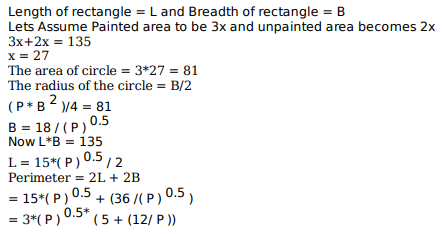
A person spent Rs 50000 to purchase a desktop computer and a laptop computer. He sold the desktop at 20% profit and the laptop at 10% loss. If overall he made a 2% profit then the purchase price, in rupees, of the desktop is
Video Explanation

Explanatory Answer
Cost of Desktop = D
Cost of Laptop = L
D + L = 50000 à Eq 1
1.2*D + 0.9*L = 51000 à Eq 2
Multiplying Eq 1 by 0.9 and subtracting with Eq 2
0.3*D = 6000
D = Rs. 20000
A straight road connects points A and B. Car 1 travels from A to B and Car 2 travels from B to A, both leaving at the same time. After meeting each other, they take 45 minutes and 20 minutes, respectively, to complete their journeys. If Car 1 travels at the speed of 60 km/hr, then the speed of Car 2, in km/hr, is
Video Explanation

Explanatory Answer

Two persons are walking beside a railway track at respective speeds of 2 and 4 km per hour in the same direction. A train came from behind them and crossed them in 90 and 100 seconds, respectively. The time, in seconds, taken by the train to cross an electric post is nearest to
Video Explanation

Explanatory Answer
Assume length of Train as L and Original speed as S
To cross the first person (2 kmph) train needs 90 seconds at S-2 km/hr and to cross the second
person (2 kmph) train needs 100 seconds at S-4 km/hr
Speeds are inversely proportional to time
(S-2)/(S-4) = (100/90)
S = 22
(S-2) = L * 3600 / 90
L = 0.5 km
T = (0.5 * 3600) / 22 = 82 seconds
Let A, B and C be three positive integers such that the sum of A and the mean of B and C is 5. In addition, the sum of B and the mean of A and C is 7. Then the sum of A and B is
Video Explanation

Explanatory Answer
A + (B+C)/2 = 5 à 2A + B + C = 10 - Eq 1
B + (A+C)/2 = 7 à A + 2B + C = 14 - Eq 2
Subtracting, Eq2 – Eq1
B = 4 + A
Adding Eq 1 and Eq 2
3(A+B) + 2C = 24 – Eq 3
Now since A B C are positive and B = 4 + A hence A+B cannot be equal to 4
In Eq 3 all components have to be even thereby eliminating 5 and 7.
Hence A+B = 6.
Veeru invested Rs 10000 at 5% simple annual interest, and exactly after two years, Joy invested Rs 8000 at 10% simple annual interest. How many years after Veeru’s investment, will their balances, i.e., principal plus accumulated interest, be equal?
Video Explanation

Explanatory Answer
2 years simple interest accrued by Veeru is Rs. 1000
10000 + 1000 + 10000*0.05*x = 8000 + 8000*0.1*x
3000 = 300x
x = 10 years
2 years of Veeru’s initial investment hence answer = 10+2 = 12 years
If f(5 + x) = f(5 – x) for every real x, and f (x) = 0 has four distinct real roots, then the sum of these roots is
Video Explanation

Explanatory Answer
As f(x) = 0 we must try to convert f(5+x) = f(5-x) in terms of f(x)
We substitute x as x-5
f(x) = f(10-x)
Lets assume x = A as a root, then we simultaneously get 10-A as a root
Similarly we assume x = B as a root, then we get 10-B as a root
the 4 roots are A, B, 10-A, 10-B
The sum of roots is 20
A train travelled at one-thirds of its usual speed, and hence reached the destination 30 minutes after the scheduled time. On its return journey, the train initially travelled at its usual speed for 5 minutes but then stopped for 4 minutes for an emergency. The percentage by which the train must now increase its usual speed so as to reach the destination at the scheduled time, is nearest to
Video Explanation

Explanatory Answer
Original speed = S & Original time = T
New Speed = S/3, speed and time are inversely proportional hence New time = 3T
The difference between times = 3T-T = 30 mins
Original time taken = 15 mins
Assume Distance is 15 Kms and Speed = 1 km/hr
In 5 mins the train travelled 5 kms and 4 mins it stopped.
In 6 mins it has to cover 10 kms
The original speed will be increased by a factor of 1.66 or 67%
If a, b and c are positive integers such that ab = 432, bc = 96 and c < 9, then the smallest possible value of a + b + c is
Video Explanation

Explanatory Answer
We need the sum of a+b+c to be minimum hence the values of a,b ,c must be as close as
possible
ab = 432 = 18*24
bc = 96 = 24*4
a + b + c = 18 + 24 + 4 = 46
A solid right circular cone of height 27 cm is cut into two pieces along a plane parallel to its base at a height of 18 cm from the base. If the difference in volume of the two pieces is 225 cc, the volume, in cc, of the original cone is
Video Explanation

Explanatory Answer
Height of Cone = 27 cm
The Larger cone after passing a plane has a smaller cone with height 9 cm (27-18)
The heights are in the ratio 9 : 27 or 1 : 3
Volumes will be in ratio of (Height) 3
Volume of smaller cone : Volume of whole cone à 1 : 27
Volume of remaining cone = 27x – 1x = 26x
26x – x = 225cc
x = 9cc
Volume of original cone = 27*9 = 243 cc
The local office of the APP-CAB company evaluates the performance of five cab drivers, Arun,
Barun, Chandan, Damodaran, and Eman for their monthly payment based on ratings in five
different parameters (P1 to P5) as given below:
P1: timely arrival
P2: behaviour
P3: comfortable ride
P4: driver's familiarity with the route
P5: value for money
Based on feedback from the customers, the office assigns a rating from 1 to 5 in each of these
parameters. Each rating is an integer from a low value of 1 to a high value of 5. The final rating
of a driver is the average of his ratings in these five parameters. The monthly payment of the
drivers has two parts – a fixed payment and final rating-based bonus. If a driver gets a rating of 1
in any of the parameters, he is not eligible to get bonus. To be eligible for bonus a driver also
needs to get a rating of five in at least one of the parameters.
The partial information related to the ratings of the drivers in different parameters and the
monthly payment structure (in rupees) is given in the table below:

The following additional facts are known.
1. Arun and Barun have got a rating of 5 in exactly one of the parameters. Chandan has got a
rating of 5 in exactly two parameters.
2. None of drivers has got the same rating in three parameters.
If Damodaran does not get a bonus, what is the maximum possible value of his final rating?
Video Explanation

Explanatory Answer
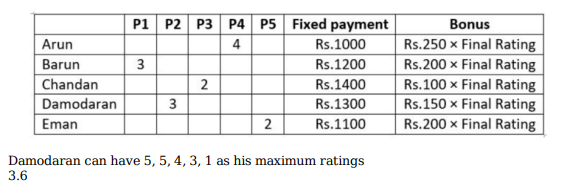
If Eman gets a bonus, what is the minimum possible value of his final rating?
Video Explanation

Explanatory Answer
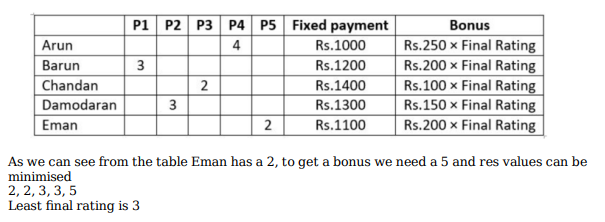
If all five drivers get bonus, what is the minimum possible value of the monthly payment (in rupees) that a driver gets?
Video Explanation

Explanatory Answer

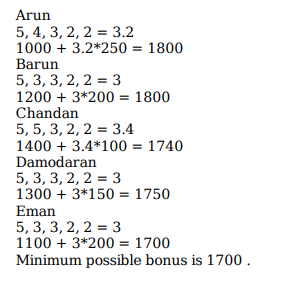
If all five drivers get bonus, what is the maximum possible value of the monthly payment (in rupees) that a driver gets?
Video Explanation

Explanatory Answer

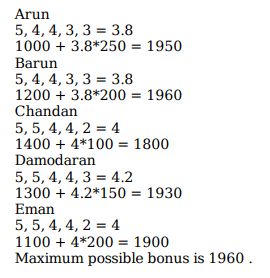
1000 patients currently suffering from a disease were selected to study the effectiveness of treatment of four types of medicines — A, B, C and D. These patients were first randomly assigned into two groups of equal size, called treatment group and control group. The patients in the control group were not treated with any of these medicines; instead they were given a dummy medicine, called placebo, containing only sugar and starch. The following information is known about the patients in the treatment group.
a. A total of 250 patients were treated with type A medicine and a total of 210 patients were treated with type C medicine.
b. 25 patients were treated with type A medicine only. 20 patients were treated with type C medicine only. 10 patients were treated with type D medicine only.
c. 35 patients were treated with type A and type D medicines only. 20 patients were treated with type A and type B medicines only. 30 patients were treated with type A and type C medicines only. 20 patients were treated with type C and type D medicines only.
d. 100 patients were treated with exactly three types of medicines.
e. 40 patients were treated with medicines of types A, B and C, but not with medicines of type D. 20 patients were treated with medicines of types A, C and D, but not with medicines of type B.
f. 50 patients were given all the four types of medicines. 75 patients were treated with exactly one type of medicine.
How many patients were treated with medicine type B?
Video Explanation

Explanatory Answer
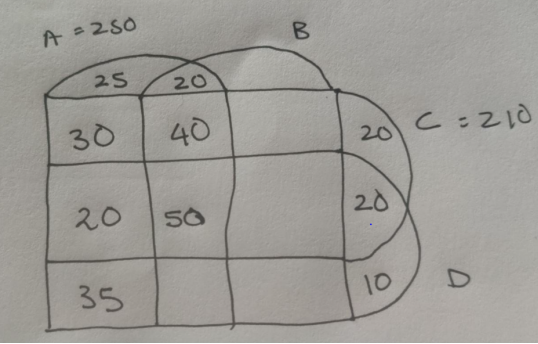
Using the Question we are able to fill the Venn diagram in the following manner.
Using Condition F, 75 patients were given only 1 medicine
Hence only B = 75 -25-20-10 = 20
And Medicine given to A, B, D but not C =
250-25-20-30-40-20-50-35 = 30
Exactly 100 people had taken 3 medicines hence Medicine given to B, C, D but not A =
100-40-20-30 = 10
And Since C has a total of 210 patients, hence Only B and C =
210-20-20-30-40-20-50-10 = 20
Total patients is 500
Only B and D = 500 – (250+20+20+10+20+20+10) = 150
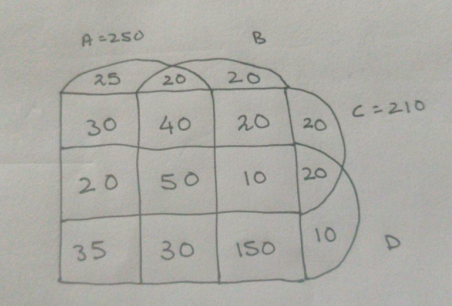
The number of patients who were treated with medicine types B, C and D, but not type A was:
Video Explanation

Explanatory Answer

Using Condition F, 75 patients were given only 1 medicine
Hence only B = 75 -25-20-10 = 20
And Medicine given to A, B, D but not C =
250-25-20-30-40-20-50-35 = 30
Exactly 100 people had taken 3 medicines hence Medicine given to B, C, D but not A =
100-40-20-30 = 10
And Since C has a total of 210 patients, hence Only B and C =
210-20-20-30-40-20-50-10 = 20
Total patients is 500
Only B and D = 500 – (250+20+20+10+20+20+10) = 150

How many patients were treated with medicine types B and D only?
Video Explanation

Explanatory Answer

Using Condition F, 75 patients were given only 1 medicine
Hence only B = 75 -25-20-10 = 20
And Medicine given to A, B, D but not C =
250-25-20-30-40-20-50-35 = 30
Exactly 100 people had taken 3 medicines hence Medicine given to B, C, D but not A =
100-40-20-30 = 10
And Since C has a total of 210 patients, hence Only B and C =
210-20-20-30-40-20-50-10 = 20
Total patients is 500
Only B and D = 500 – (250+20+20+10+20+20+10) = 150

The number of patients who were treated with medicine type D was:
Video Explanation

Explanatory Answer

Using Condition F, 75 patients were given only 1 medicine
Hence only B = 75 -25-20-10 = 20
And Medicine given to A, B, D but not C =
250-25-20-30-40-20-50-35 = 30
Exactly 100 people had taken 3 medicines hence Medicine given to B, C, D but not A =
100-40-20-30 = 10
And Since C has a total of 210 patients, hence Only B and C =
210-20-20-30-40-20-50-10 = 20
Total patients is 500
Only B and D = 500 – (250+20+20+10+20+20+10) = 150

Ten musicians (A, B, C, D, E, F, G, H, I and J) are experts in at least one of the following three percussion instruments: tabla, mridangam, and ghatam. Among them, three are experts in tabla but not in mridangam or ghatam, another three are experts in mridangam but not in tabla or ghatam, and one is an expert in ghatam but not in tabla or mridangam. Further, two are experts in tabla and mridangam but not in ghatam, and one is an expert in tabla and ghatam but not in mridangam.
The following facts are known about these ten musicians.
1. Both A and B are experts in mridangam, but only one of them is also an expert in tabla.
2. D is an expert in both tabla and ghatam.
3. Both F and G are experts in tabla, but only one of them is also an expert in mridangam.
4. Neither I nor J is an expert in tabla.
5. Neither H nor I is an expert in mridangam, but only one of them is an expert in ghatam.
Who among the following is DEFINITELY an expert in tabla but not in either mridangam or ghatam?
Video Explanation

Explanatory Answer
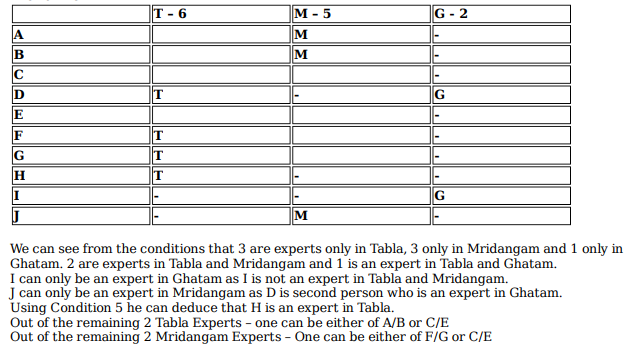
Who among the following is DEFINITELY an expert in mridangam but not in either tabla or ghatam?
Video Explanation

Explanatory Answer

Which of the following pairs CANNOT have any musician who is an expert in both tabla and mridangam but not in ghatam?
Video Explanation

Explanatory Answer
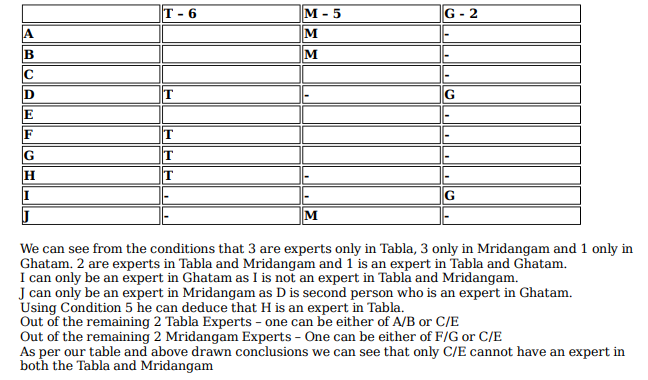
If C is an expert in mridangam and F is not, then which are the three musicians who are experts in tabla but not in either mridangam or ghatam?
Video Explanation

Explanatory Answer
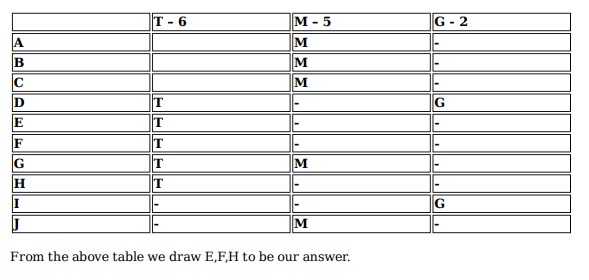
Four institutes, A, B, C, and D, had contracts with four vendors W, X, Y, and Z during the ten calendar years from 2010 to 2019. The contracts were either multi-year contracts running for several consecutive years or single-year contracts. No institute had more than one contract with the same vendor. However, in a calendar year, an institute may have had contracts with multiple vendors, and a vendor may have had contracts with multiple institutes. It is known that over the decade, the institutes each got into two contracts with two of these vendors, and each vendor got into two contracts with two of these institutes.
The following facts are also known about these contracts.
I. Vendor Z had at least one contract in every year.
II. Vendor X had one or more contracts in every year up to 2015, but no contract in any year after that.
III. Vendor Y had contracts in 2010 and 2019. Vendor W had contracts only in 2012.
IV. There were five contracts in 2012.
V. There were exactly four multi-year contracts. Institute B had a 7-year contract, D had a 4-year contract, and A and C had one 3-year contract each. The other four contracts were single-year contracts.
VI. Institute C had one or more contracts in 2012 but did not have any contract in 2011.
VII. Institutes B and D each had exactly one contract in 2012. Institute D did not have any contract in 2010.
In which of the following years were there two or more contracts?
Video Explanation

Explanatory Answer
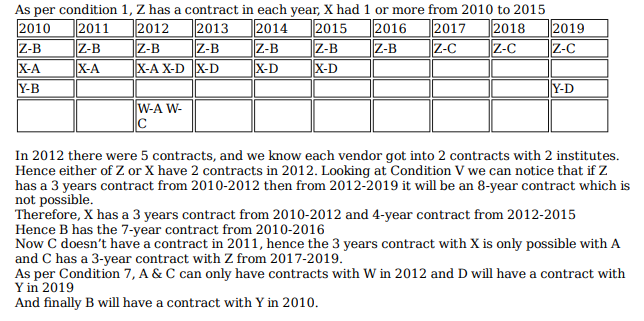
Which of the following is true?
Video Explanation

Explanatory Answer

In how many years during this period was there only one contract?
Video Explanation

Explanatory Answer

What BEST can be concluded about the number of contracts in 2010?
Video Explanation

Explanatory Answer

Which institutes had multiple contracts during the same year?
Video Explanation

Explanatory Answer

Which institutes and vendors had more than one contracts in any year?
Video Explanation

Explanatory Answer

In a certain board examination, students were to appear for examination in five subjects: English, Hindi, Mathematics, Science and Social Science. Due to a certain emergency situation, a few of the examinations could not be conducted for some students. Hence, some students missed one examination and some others missed two examinations. Nobody missed more than two examinations.
The board adopted the following policy for awarding marks to students. If a student appeared in all five examinations, then the marks awarded in each of the examinations were on the basis of the scores obtained by them in those examinations.
If a student missed only one examination, then the marks awarded in that examination was the average of the best three among the four scores in the examinations they appeared for.
If a student missed two examinations, then the marks awarded in each of these examinations was the average of the best two among the three scores in the examinations they appeared for.
The marks obtained by six students in the examination are given in the table below. Each of them missed either one or two examinations.
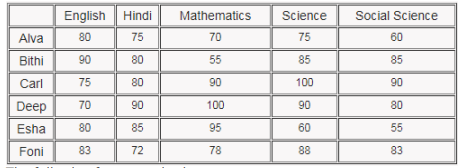
The following facts are also known.
I. Four of these students appeared in each of the English, Hindi, Science, and Social Science examinations.
II. The student who missed the Mathematics examination did not miss any other examination.
Ill. One of the students who missed the Hindi examination did not miss any other examination. The other student who missed the Hindi examination also missed the Science examination.
Who among the following did not appear for the Mathematics examination?
Video Explanation

Explanatory Answer
In this we check for the 4 options
Carl – Mathematics score = 90
This is average of best three scores 100 + 80 + 90 = 270/3 = 90
Alva – Mathematics score = 70
This cannot be the average of best three or best 2 scores
Esha – Mathematics score = 95
This is her highest score hence this is not the possible answer
Foni - – Mathematics score = 78
This cannot be the average of best three or best 2 scores
Hence Answer is Carl.
Which students did not appear for the English examination?
Video Explanation

Explanatory Answer
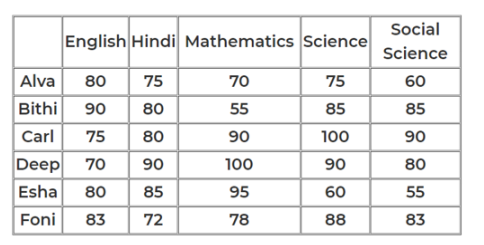
Alva and Bithi have scored the highest in English, hence they haven’t missed it.
Carl and deep have the least score in English, hence they haven’t missed it.
Esha scored 80 which is the average of (95+85+60)/3 = 80
Foni scored 83 which is the average of (88+83+78)/3 = 83
What BEST can be concluded about the students who did not appear for the Hindi examination?
Video Explanation

Explanatory Answer
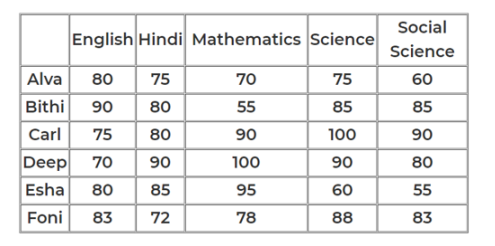
We need to check only for the ones given in the options
Alva – Hindi = 75
Average of (80+75+70)/3 = 75
Deep – Hindi = 90
Average of (100+90+80)/3 = 90
Esha – Hindi = 85
This is not the average of best 3 or 2 subjects
Hence Alva and Deep.
What BEST can be concluded about the students who missed the Science examination?
Video Explanation

Explanatory Answer

We need to check only for the ones given in the options
Alva – Hindi = 75
Average of (80+75+70)/3 = 75
Deep – Hindi = 90
Average of (100+90+80)/3 = 90
Esha – Hindi = 85
This is not the average of best 3 or 2 subjects
Hence Alva and Deep.
How many out of these six students missed exactly one examination?
Video Explanation

Explanatory Answer
Now we know that Carl only missed maths and Esha only English.
One student who missed hindi also missed science
Exams which can be missed
Alva – Hindi or Science
Bithi – Social Science and Science
Carl – Mathematics
Deep – Hindi or science
Esha – English
Foni – English and Social Science
Hence 3
For how many students can we be definite about which examinations they missed?
Video Explanation

Explanatory Answer
Exams which can be missed
Alva – Hindi or Science
Bithi – Social Science and Science
Carl – Mathematics
Deep – Hindi or science
Esha – English
Foni – English and Social Science
Either Alva or Deep can be the one who missed both Hindi and Science. Rest we are definite
Hence 4 .















